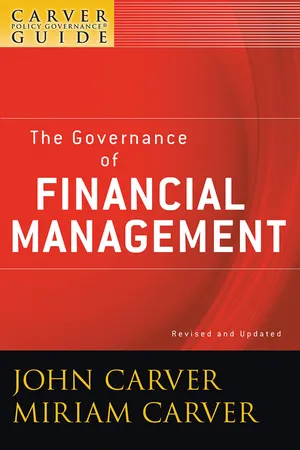All boards worry about money. They should. After all, they are accountable for how their organizations handle money. But the board is accountable for everything, not just money. Therefore, in this Guide, our description of governing financial matters is based on broader principles, ones that describe the whole job of the board, not just one part of it.
• The board exists to act as the informed voice and agent of the owners, whether they are owners in a legal or moral sense. All owners are stakeholders but not all stakeholders are owners, only those whose position in relation to an organization is equivalent to the position of shareholders in a for-profit corporation.
• The board is accountable to owners that the organization is successful. As such, it is not advisory to staff but an active link in the chain of command. All authority in the staff organization and in components of the board flows from the board.
• The authority of the board is held and used as a body. The board speaks with one voice in that instructions are expressed by the board as a whole. Individual board members have no authority to instruct staff.
• The board defines in writing its expectations about the intended effects to be produced, the intended recipients of those effects, and the intended worth (cost-benefit or priority) of the effects. These are Ends policies. All decisions made about effects, recipients, and worth are ends decisions. All decisions about issues that do not fit the definition of ends are means decisions. Hence in Policy Governance, means are simply not ends.
• The board defines in writing the job results, practices, delegation style, and discipline that make up its own job. These are board means decisions, categorized as Governance Process policies and Board-Management Delegation policies.
• The board defines in writing its expectations about the means of the operational organization. However, rather than prescribing board-chosen means—which would enable the CEO to escape accountability for attaining ends—these policies define limits on operational means, thereby placing boundaries on the authority granted to the CEO. In effect, the board describes those means that would be unacceptable even if they were to work. These are Executive Limitations policies.
• The board decides its policies in each category first at the broadest, most inclusive level. It further defines each policy in descending levels of detail until reaching the level of detail at which it is willing to accept any reasonable interpretation by the applicable delegatee of its words thus far. Ends, Executive Limitations, Governance Process, and Board-Management Delegation policies are exhaustive in that they establish control over the entire organization, both board and staff. They replace, at the board level, more traditional documents such as mission statements, strategic plans, and budgets.
• The identification of any delegatee must be unambiguous as to authority and responsibility. No subparts of the board, such as committees or officers, can be given jobs that interfere with, duplicate, or obscure the job given to the CEO.
• More detailed decisions about ends and operational means are delegated to the CEO if there is one. If there is no CEO, the board must delegate to two or more delegatees, avoiding overlapping expectations or causing disclarity about the authority of the various managers. In the case of board means, delegation is to the CGO unless part of the delegation is explicitly directed elsewhere, for example, to a committee. The delegatee has the right to use any reasonable interpretation of the applicable board policies.
• The board must monitor organizational performance against previously stated Ends policies and Executive Limitations policies. Monitoring is only for the purpose of discovering if the organization achieved a reasonable interpretation of these board policies. The board must therefore judge the CEO’s interpretation, rationale for its reasonableness, and the data demonstrating the accomplishment of the interpretation. The ongoing monitoring of the board’s Ends and Executive Limitations policies constitutes the CEO’s performance evaluation.
